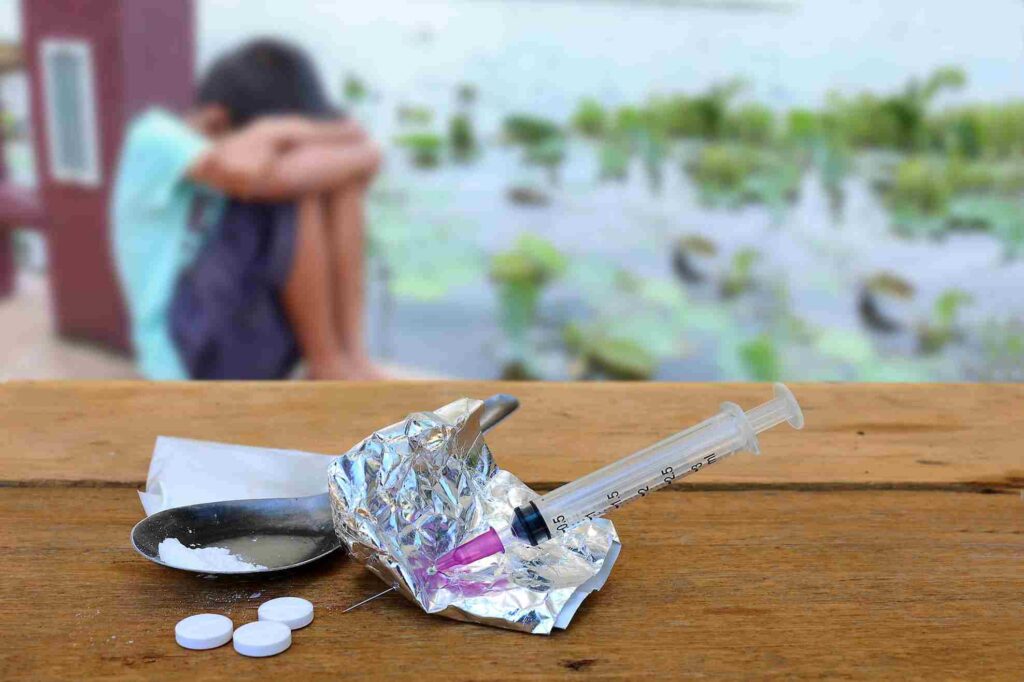In a world where addiction is a formidable adversary, its complexities often extend beyond a single substance or behavior. Enter cross addiction, a phenomenon where individuals, already grappling with one form of addiction, find themselves ensnared by another. Here, we will unravel the layers of cross addiction, shedding light on its causes, consequences, and the paths to liberation.
Contents
What Is Cross Addiction?
 Cross addiction, also known as addiction transfer or secondary addiction, refers to a phenomenon where individuals who are struggling with one form of addiction, whether it be to substances like drugs or alcohol or behaviors like gambling or shopping, develop another addiction to a different substance or behavior. Essentially, it involves the substitution of one compulsive behavior or substance use for another.
Cross addiction, also known as addiction transfer or secondary addiction, refers to a phenomenon where individuals who are struggling with one form of addiction, whether it be to substances like drugs or alcohol or behaviors like gambling or shopping, develop another addiction to a different substance or behavior. Essentially, it involves the substitution of one compulsive behavior or substance use for another.
This can occur concurrently with the primary addiction or emerge later in the recovery process. Cross-addiction underscores the complex nature of addiction, highlighting how underlying psychological and physiological factors can contribute to a pattern of compulsive behaviors that transcend specific substances or activities.
What Are The Symptoms To Identify?
Symptoms of cross-addiction can vary widely depending on the individual and the nature of their primary and secondary addictive behaviors. However, some common signs and symptoms may include:
- Preoccupation: Obsessive thoughts or cravings related to the secondary addictive behavior or substance, often leading to increased time spent engaging in the behavior or seeking out the substance.
- Loss of Control: Difficulty controlling or limiting the frequency or intensity of the secondary addictive behavior or substance use, despite negative consequences such as financial problems, relationship conflicts, or health issues.
- Withdrawal Symptoms: Experience physical or psychological withdrawal symptoms when attempting to cut back or stop the secondary addictive behavior or substance use, indicating a physiological dependence.
- Tolerance: Needing increasing amounts of the substance or engaging in the behavior more frequently to achieve the desired effect, indicating a buildup of tolerance.
- Neglect of Responsibilities: Neglecting important obligations such as work, school, or family responsibilities in favor of engaging in secondary addictive behavior or substance use.
- Continued Use Despite Consequences: Persisting in the addictive behavior or substance use despite awareness of negative consequences, such as legal issues, deteriorating relationships, or declining physical or mental health.
- Secrecy and Isolation: Engaging in the behavior or substance use in secrecy or isolating oneself from loved ones to hide the extent of the addiction.
- Mood Changes: Mood swings, irritability, anxiety, or depression when unable to engage in the addictive behavior or access the substance, indicating a psychological dependence.
Recognizing these symptoms is essential for early intervention and effective treatment to address both the primary and secondary addictive behaviors comprehensively.
What Causes Cross Addiction?
 Cross-addiction is influenced by a combination of genetic, biological, psychological, and environmental factors. Some potential causes and contributing factors include:
Cross-addiction is influenced by a combination of genetic, biological, psychological, and environmental factors. Some potential causes and contributing factors include:
- Genetic Predisposition
Individuals with a family history of addiction may have a genetic vulnerability to addictive behaviors. And, making them more susceptible to developing multiple addictions.
- Neurobiology
Changes in brain chemistry and reward pathways can contribute to the development of addictive behaviors. This addiction may occur as individuals seek out alternative substances or activities to stimulate the same reward centers in the brain.
- Psychological Factors
Underlying mental health issues such as depression, anxiety, trauma, or low self-esteem can increase the risk of developing addictive behaviors. The desire to alleviate emotional distress or escape from negative feelings may drive individuals to seek solace in addictive substances or behaviors.
- Social Environment
Exposure to peer pressure, societal norms, or environments that promote substance use or addictive behaviors can influence an individual’s likelihood of developing cross-addiction. Social factors such as stress, peer influence, or social isolation can also contribute to the maintenance of addictive behaviors.
- Coping Mechanisms
Some individuals may turn to addictive substances or behaviors as a way to cope with stress, trauma, or life challenges. The temporary relief provided by these coping mechanisms can reinforce the cycle of addiction and lead to the development of this condition over time.
- Previous Addiction Treatment
In some cases, individuals who have successfully overcome one addiction may be at increased risk of developing the condition as they seek alternative ways to cope with stress or fill the void left by their previous addictive behavior.
Understanding the complex interplay of these factors is crucial for developing effective prevention strategies and treatment approaches. Treatment often involves a holistic approach that addresses both the physical and psychological aspects of addiction, along with addressing any co-occurring mental health issues.
What Are The Consequences And Risks?
Cross-addiction can have significant consequences and risks that impact various aspects of an individual’s life.
Common risks
Below are the common risks and consequences to be aware of:
Health Risks
Engaging in multiple addictive behaviors or substance use can lead to serious health consequences, including cardiovascular problems, liver disease, respiratory issues, and neurological impairments. The cumulative effects of substance abuse and addictive behaviors can increase the risk of overdose, accidents, and premature death.
Mental Health Implications
It is often associated with co-occurring mental health disorders such as depression, anxiety, bipolar disorder, or personality disorders. The presence of multiple addictive behaviors can exacerbate existing mental health symptoms and hinder effective treatment outcomes.
Financial Strain
Addiction can lead to financial instability due to the costs associated with purchasing substances or engaging in addictive behaviors. Individuals may experience financial hardship, debt, or legal issues as a result of their addictive behaviors, impacting their ability to meet basic needs and maintain a stable lifestyle.
Relationship Problems
Addiction can strain relationships with family members, friends, romantic partners, and colleagues. The secrecy, dishonesty, and behavioral changes associated with addiction can erode trust, communication, and intimacy, leading to conflicts, breakups, or estrangement.
Legal Consequences
Engaging in illegal activities to support addictive behaviors, such as theft, fraud, or drug trafficking, can result in legal repercussions such as arrest, imprisonment, or fines. Substance abuse can also impair judgment and increase the likelihood of engaging in risky behaviors that may result in legal consequences.
Decline in Functioning
Addiction can impair cognitive function, decision-making abilities, and overall functioning in various domains of life, including work, school, and social interactions. Individuals may experience a decline in productivity, academic performance, or job retention, further exacerbating financial and interpersonal challenges.
Relapse Risk
Managing multiple addictive behaviors simultaneously can increase the risk of relapse, as individuals may struggle to maintain abstinence or control over their impulses. The presence of triggers, stressors, or co-occurring mental health issues can further complicate the recovery process.
Understanding these consequences and risks is essential for individuals to seek help and support from appropriate treatment resources. Comprehensive treatment approaches that address both primary and secondary addictive behaviors can promote recovery and improve overall well-being.
What Are The Treatment Approaches For Cross Addiction?
 Treating cross-addiction often requires a comprehensive and individualized approach that addresses both the primary and secondary addictive behaviors, along with any underlying mental health issues.
Treating cross-addiction often requires a comprehensive and individualized approach that addresses both the primary and secondary addictive behaviors, along with any underlying mental health issues.
Best options
Some effective treatment approaches include:
Dual Diagnosis Treatment
Since the condition often co-occurs with other mental health disorders, such as depression, anxiety, or trauma-related disorders, integrated treatment for dual diagnosis is essential. This approach involves simultaneously addressing both addiction and mental health issues through therapies such as cognitive-behavioral therapy (CBT), dialectical behavior therapy (DBT), and trauma-focused therapies.
Behavioral Therapies
Various behavioral therapies, such as contingency management, motivational interviewing, and relapse prevention, can be effective in the treatment. These therapies help individuals identify triggers, develop coping skills, and modify addictive behaviors by reinforcing positive changes and addressing underlying psychological factors.
Pharmacotherapy
Medications may be prescribed to help manage withdrawal symptoms, reduce cravings, or treat co-occurring mental health disorders. For example, medications such as buprenorphine or naltrexone may be used to treat opioid or alcohol dependence, while antidepressants or anti-anxiety medications may help manage mood symptoms.
Support Groups
Participation in support groups, such as Alcoholics Anonymous (AA), Narcotics Anonymous (NA), or SMART Recovery, can provide individuals with peer support, accountability, and encouragement throughout their recovery journey. Support groups offer a sense of community, acceptance, and understanding. It can be invaluable in maintaining sobriety and preventing relapse.
Holistic Approaches
Holistic therapies, including mindfulness meditation, yoga, acupuncture, and art therapy, can complement traditional treatment approaches by promoting relaxation, stress reduction, and emotional well-being. These therapies address the interconnectedness of mind, body, and spirit, promoting holistic healing and recovery.
Family Therapy
Involving family members in the treatment process can be beneficial in addressing relational dynamics, improving communication, and strengthening support systems. Family therapy helps individuals and their loved ones understand the impact of addiction on family dynamics and develop healthy coping strategies for recovery.
Aftercare Planning
Developing a comprehensive aftercare plan is essential for sustaining long-term recovery from cross-addiction. This may involve ongoing therapy, participation in support groups, regular monitoring of progress, and relapse prevention strategies. Aftercare planning helps individuals transition back into their daily lives while maintaining the skills and support necessary to prevent relapse.
By incorporating these treatment approaches into a personalized treatment plan, individuals struggling with cross-addiction can address the underlying issues driving addictive behaviors, learn healthy coping strategies, and build a foundation for lasting recovery.
Conclusion
In conclusion, cross-addiction is a complex challenge that affects many individuals, but with the right support and treatment, recovery is possible. By understanding the underlying causes, recognizing the signs and symptoms, and accessing comprehensive treatment approaches that address both primary and secondary addictive behaviors, individuals can embark on a journey toward healing and reclaiming their lives.
It’s essential to seek help from qualified professionals, engage in support groups, and develop healthy coping strategies to navigate the ups and downs of recovery successfully. Remember, you are not alone, and there is hope for a brighter future beyond addiction.
